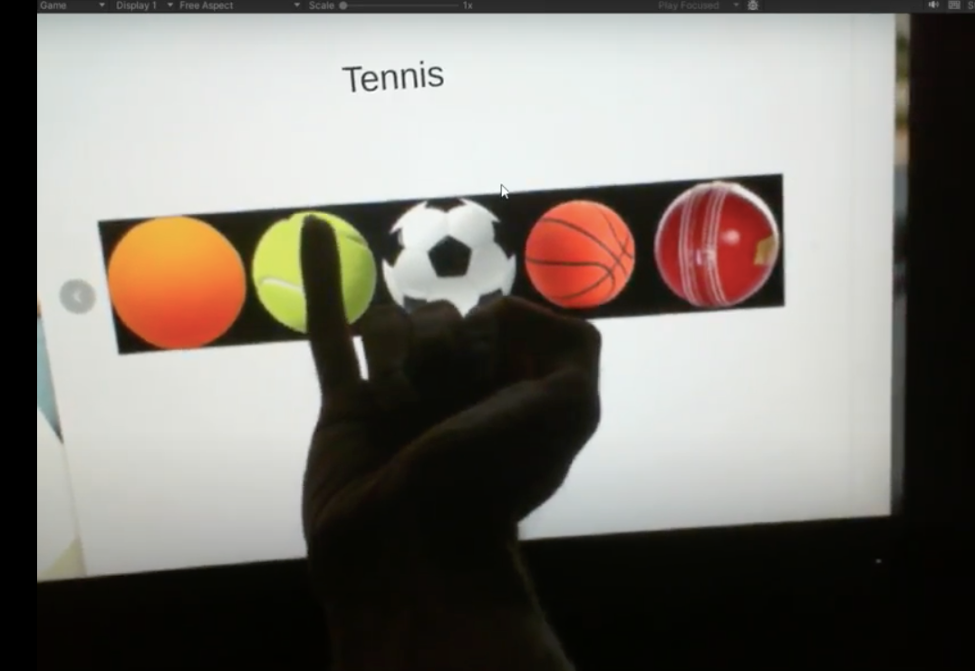Assignment 2/3 Developmet of Interface Application AR
A downloadable game
1. INTRODUCTION
Augmented Reality (AR) presents a unique blend of the digital and tangible worlds. In educational contexts, where engagement can determine the depth of learning, AR becomes a tool that goes beyond traditional paradigms. Instead of having children passively absorb information, this technology invites them to interact, explore, and experience knowledge. For this assignment, our team developed an application tailored for elementary students, offering them an innovative method to recognize and associate various sports with their respective balls.
2. DESCRIPTION OF THE APPLICATION
Designed for elementary school students, this application occupies a special position in the world of educational technology. The premise is straightforward yet captivating. When presented with a 2D image of five different balls, children can point their fingers towards each one. As they do, the application audibly identifies the sport associated with that particular ball. Instead of merely observing a picture, the learners actively engage, deducing relationships between sports and balls, playing a game of association, and enhancing their knowledge retention. This transforms a basic activity of identification into an interactive learning experience, all achieved through the innovative application of AR.
3. INTERACTION DESIGN
For creatin of this interface application , we need to make sure it provides a real world usability in education for the children.Childhood is characterized by a natural urge to touch, feel, and understand the surroundings. This application harnesses that instinct. Instead of relying on complicated commands, the interface is designed for straightforward finger-pointing. Once a child points at a ball, the application immediately responds by announcing the corresponding sport. We used a 2d image and the balls where from This design ensures that even users unfamiliar with technology find it easy and intuitive. It's an approach rooted deeply in understanding the behaviors and learning patterns of young children.
3.1 Balls image from various sports.

3.1 Hovering fingers over the image via camera.

4. TECHNICAL DEVELOPMENT
Creating an application that appears simple to the end-user often requires sophisticated technology behind the scenes. At its core, the application is built on Unity 3D,we used the concepts in the AR tutorials as well as lecture, Unity is a leading platform in the domain of game and app development. Unity 3D provides the stability and adaptability needed for such projects.
The AR functionality is facilitated by Vuforia, which excels at superimposing digital elements onto real-world visuals. When students point the application towards the 2D image of balls, Vuforia, in conjunction with Unity, enables the identification process. Images are stored in the Vuforia database which are used by importing to be used as targets. We used the information from the tutorial 1 on how we can setup the data base and use image as targets fro ArCamera interaction.
The interactivity and response mechanism are programmed using C Sharp (C#) scripts. These scripts determine how the application discerns user input and produces an appropriate audio output. Through this design, students receive instant feedback, reinforcing their learning in real-time.
We asked gpt for creating a C# script that will handle the virtual button events. This is the code which can give some glimpse at the functionality.
5. DESCRIPTIONS OF 3D MODELS
While the primary focus is on 2D images, the beauty of AR lies in its ability to transform flat visuals into multi-dimensional experiences. Because the simple 2d image we createdIn this application, though the students interact with a 2D image, the AR technology works in the background to provide depth to their interactions. Each ball, when pointed at, becomes more than just a picture; it becomes a gateway to knowledge about a sport. The aim is to make learning multi-layered and engaging.

6. FUTURE IMPLICATIONS
Education is an ever-evolving field, with technologies like AR ushering in the next wave of innovations. While this application provides a glimpse, the horizon promises even more immersive and tailored learning experiences. Elementary education, in particular, can benefit immensely as engagement-driven tools become more commonplace. As AR becomes more refined, there's a potential for educators to craft even more personalized and adaptive learning environments.
7. CONCLUSION
This application is a reflection of the convergence of education and cutting-edge technology. It exemplifies the potential of AR in redefining elementary education, steering us towards a future where learning is more interactive and explorative. Usage of virtual reality can create an environment that would be more interactive for students apart from the conventiponal approach.
REFERENCES:
Herpich, F., Nunes, F.B., Petri, G. and Tarouco, L.M.R., 2019. How Mobile Augmented Reality Is Applied in Education? A Systematic Literature Review. Creative Education, 10(07), pp.1589-1627
Roopa, D., Prabha, R. and Senthil, G.A., 2021. Revolutionizing education system with interactive augmented reality for quality education. Materials Today: Proceedings
Freeiconspng.com, 2014. Free Icons and PNG Backgrounds.
OpenAI, 2022. Introducing ChatGPT. OpenAI.
https://chat.openai.com/share/e048091e-64a4-4275-8887-80469278bf28
Dipti, R. and Dhotre, 2016. Research on Object Based Augmented Reality Using Unity3d in Education System
| Status | Released |
| Author | hirenddesai |
Download
Development log
- AssignmentvirtalrealityAug 23, 2023